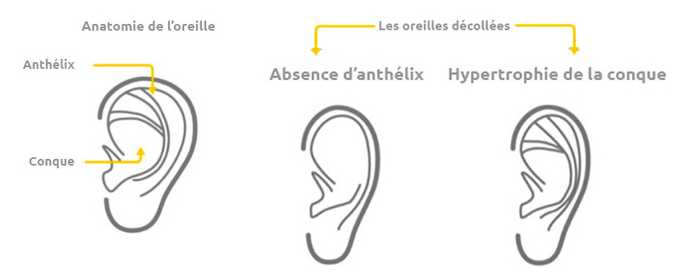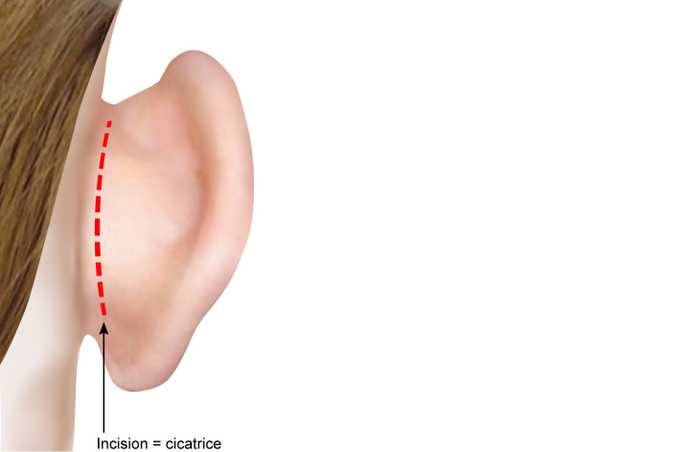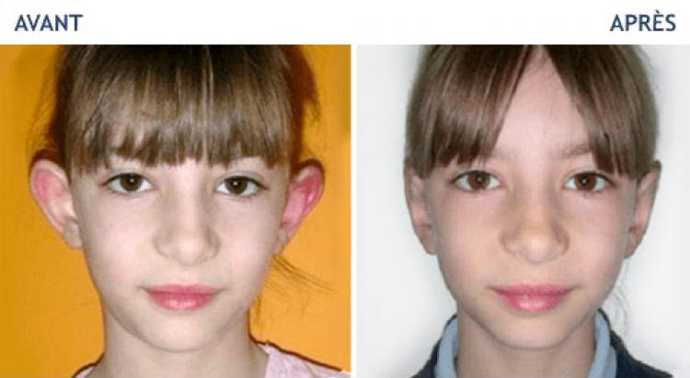What is commonly called "prominent ears" (or “protruding ears”) corresponds to associated malformations of the ear. An otoplasty is a cosmetic surgery of the ears that corrects the abnormalities of the cartilage of the ear, so as to recreate a harmonious face. Surgical correction of prominent ears can be performed on adults, adolescents and children. Under specific conditions, an otoplasty can be covered by social security and health insurances.
Prominent ears and "normal" ears
Ears are considered "normal" when their width is between 50 and 60% of their length with an average of 3 to 4.5 cm in width and a length of 5.5 to 7 cm. Front view, the ear extends from the eyebrow to the lower part of the nose. The angle between the ear and the skull averages 25° for men and 21° for women.
What are prominent ears (or protruding ears) ?
We can consider that ears are "detached" when the angle they form with the skull is greater than the average and / or when the conch is not parallel to the skull. The ears are then too obvious when viewed from the front.
Characteristics of the prominent ears
The prominent ears are generally characterized by three malformations, often associated:
- An excessive retro-auricular angle between the ear and the skull,
- Excessive projection of the ear due to hypertrophy of the cartilage (conch),
- An absence of relief caused by a malformation of the cartilage which is not folded enough on itself (the antihelix).

What is an otoplasty?
The principle of the otoplasty procedure is to correct the atrial cartilage malformations responsible for the "detached" aspect of the ear:
- Fold the cartilage part that is not enough folded,
- Bury the part of the cartilage that is too externalized,
- Reduce the cartilage part too important
Excision alone of the posterior skin of the ear does not make it possible to obtain the desired result because of the elasticity of the tissues.
A biological assessment is often performed prior to the operation.
Otoplasty for children?
A child can be operated as soon as he becomes aware of this malformation. If he is not able to understand the interest of the intervention, he will retain only the inconvenience.
This intervention is usually practiced at the entrance to primary school, college entrance or adolescence.
For which type of patient?
An otoplasty is appropriate to any person, child or adult with prominent ears or any other malformations of the ears. The ears reached 85% of their adult size at the age of 3 years.
There are three peaks of age at which this type of intervention is performed:
- Between 4 and 6 years, because it is at the primary entrance that the child becomes aware of the gene and undergoes any mockery. Before this age, as long as he is not aware of the defect, it is useless to operate it, he will retain only the inconvenience of the intervention without understanding the interest.
- If no discomfort was felt during childhood, it can appear with adolescence.
- Finally, as an adult.
Follow-up: Surgery of prominent ears
The procedure is performed under local anesthesia to limit intraoperative bleeding as well as postoperative pain. General anesthesia (often laryngeal mask) can be considered and associated for reasons of comfort (especially when the patient is a child).
Day hospitalization
A bandage must be maintained the first night following the surgery. The next day, it will be replaced by a headband (the type of a tennis headband) which must be maintained night and day for ten days and then only at night for twenty additional days.
The used threads are removed after 8 to 10 days if they do not resolve spontaneously.
The first night is a little painful because of the postoperative edema. The pain decreases rapidly the following days.
Scars
The scar induced by the operation is almost invisible insofar as it is placed behind the ear (in the hollow).

An otoplasty presents the risks inherent in any surgical procedure, but in a moderate way.
_Smoking increases the risk of surgical complications of any surgery. Stopping smoking 6-8 weeks before the procedure eliminates this additional risk. If you smoke, talk to your doctor, surgeon, and anesthesiologist, or call Tobacco-Info-Service at 3989 to help reduce risk and put the odds on your side. _
Reimbursement of an otoplasty
Insomuch as the prominent ears are considered a congenital malformation, an otoplasty can be paid by the Health Insurance / Social Security (CPAM) in the following cases:
- For children who have loose ears.
- For adults in case of significant social impact. Other adult cases are considered aesthetic and therefore unsupported.
The possible supplements of fees are with the load of the patient or its possible mutual for all or part.
An aesthetic quote or a notice of additional fees is given to the patient at the end of the preoperative consultation allowing him to learn about his eventual care by social security and his mutual health.
> See conditions of reimbursement of an otoplasty by the social security
